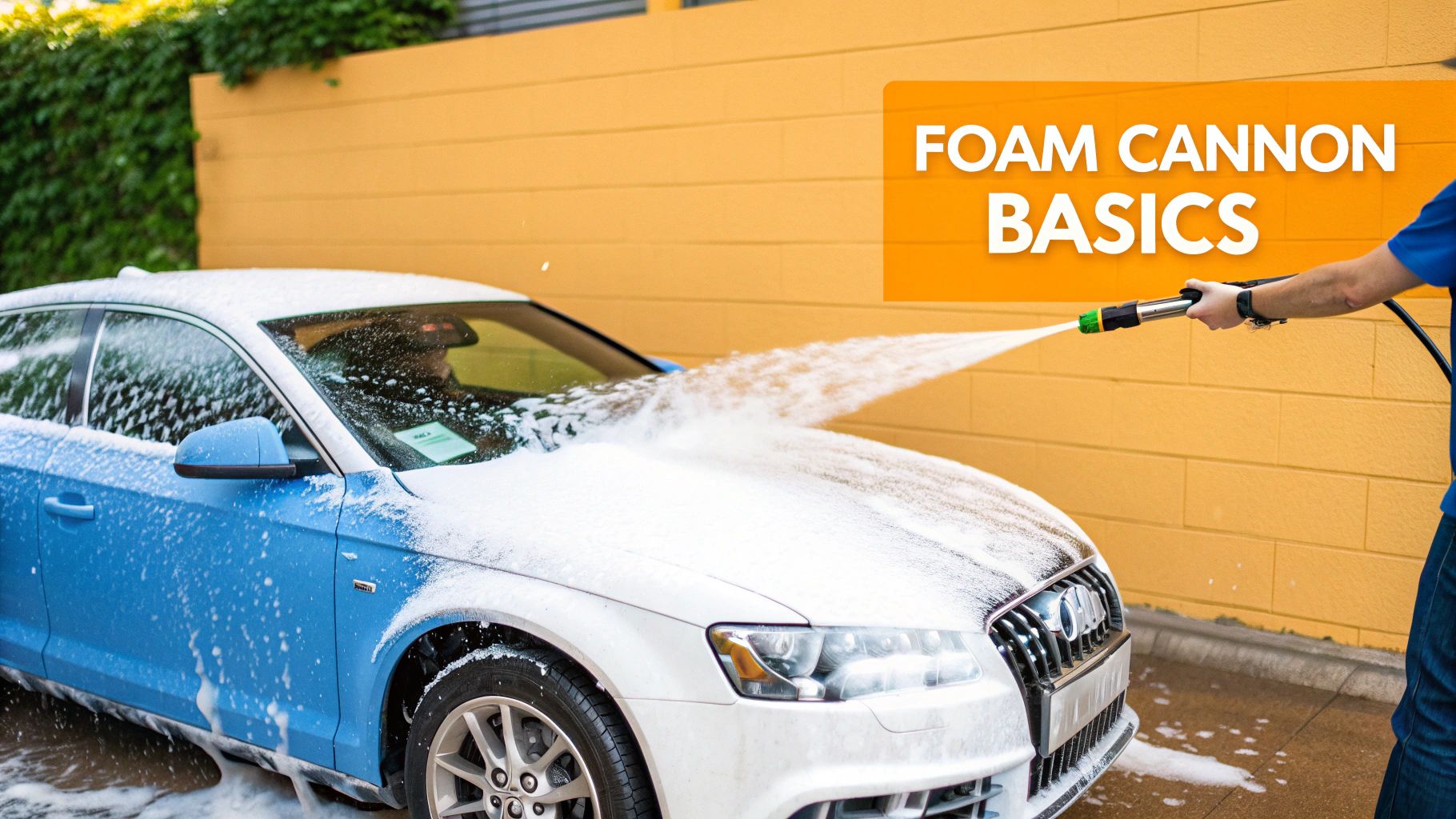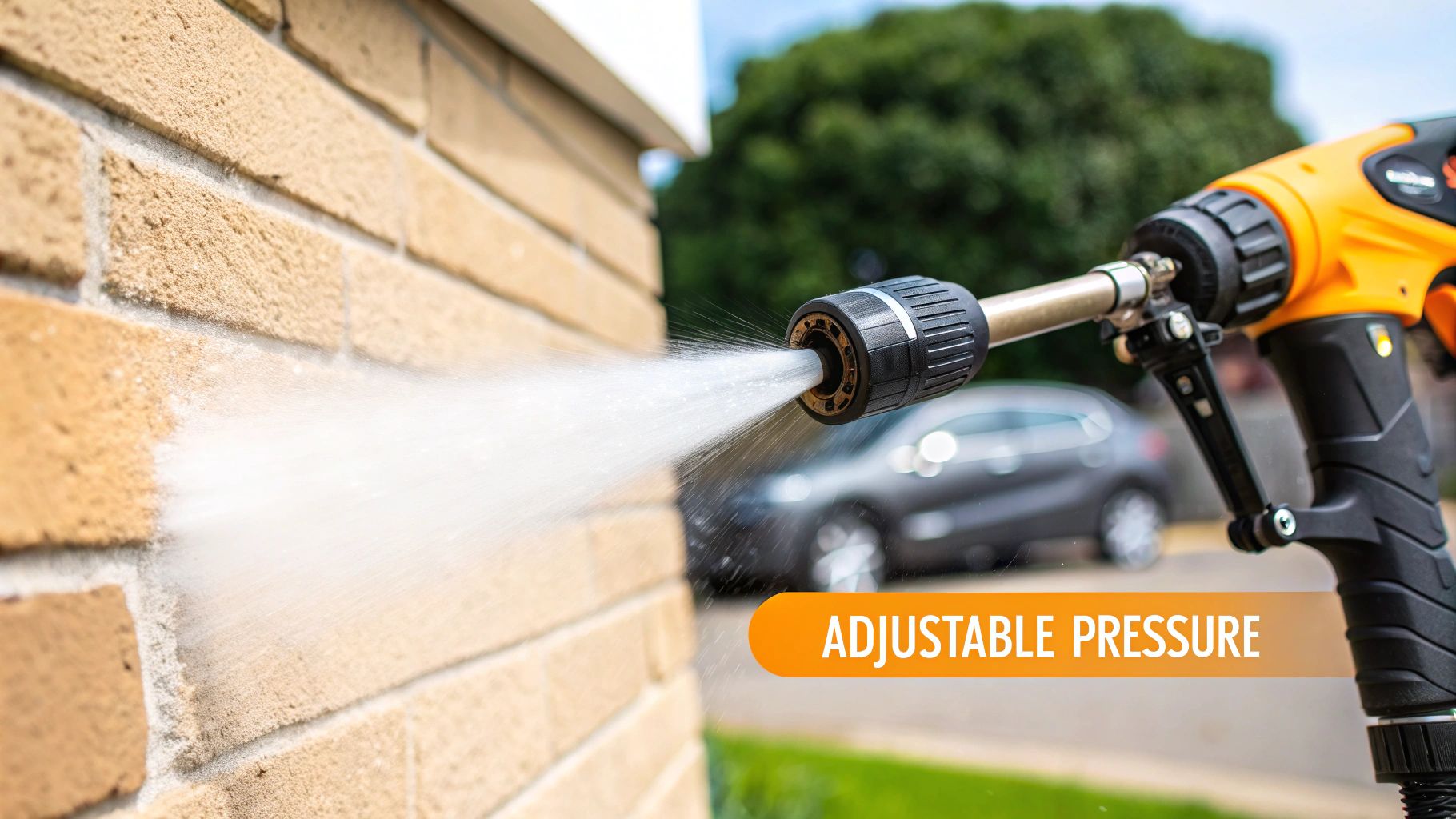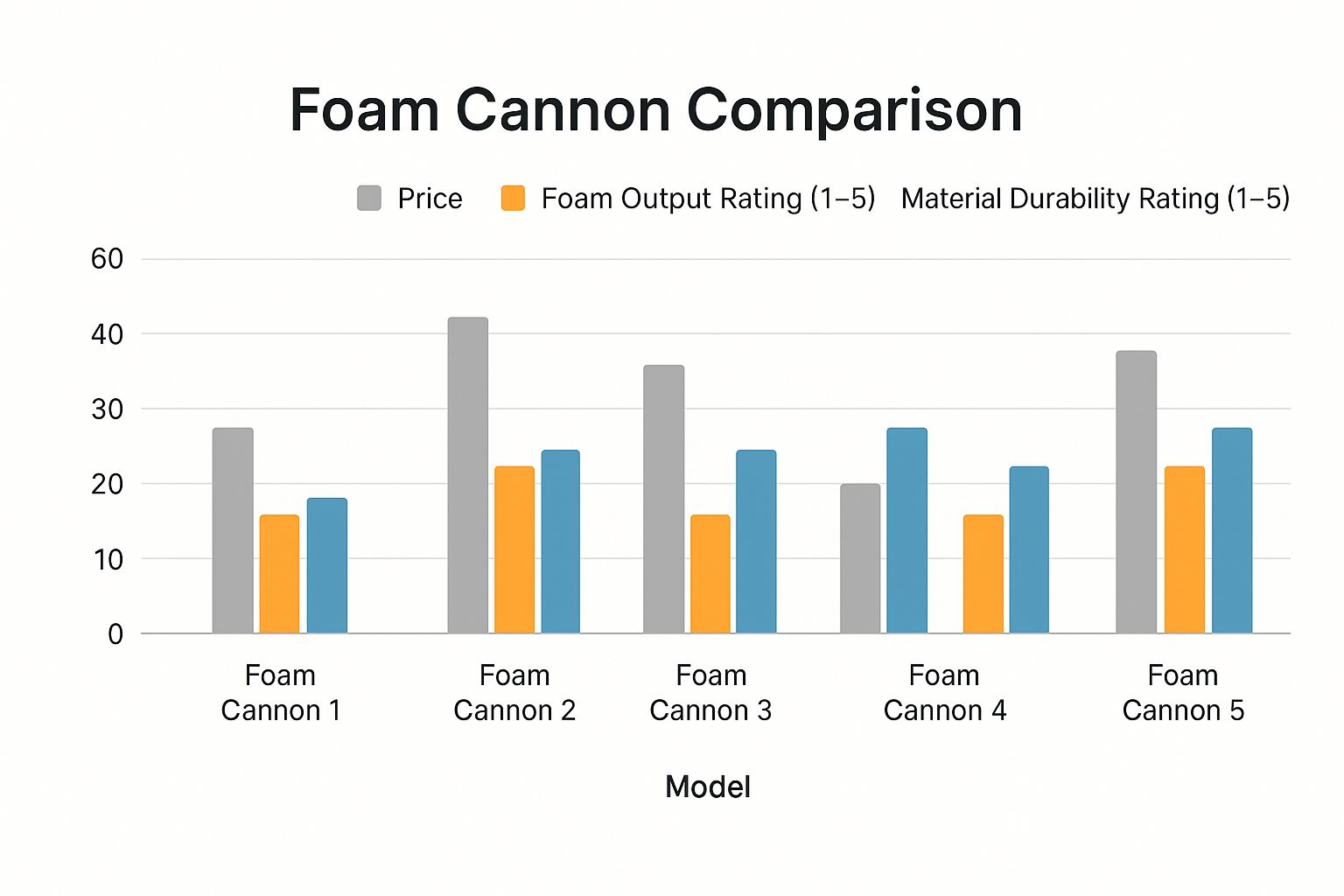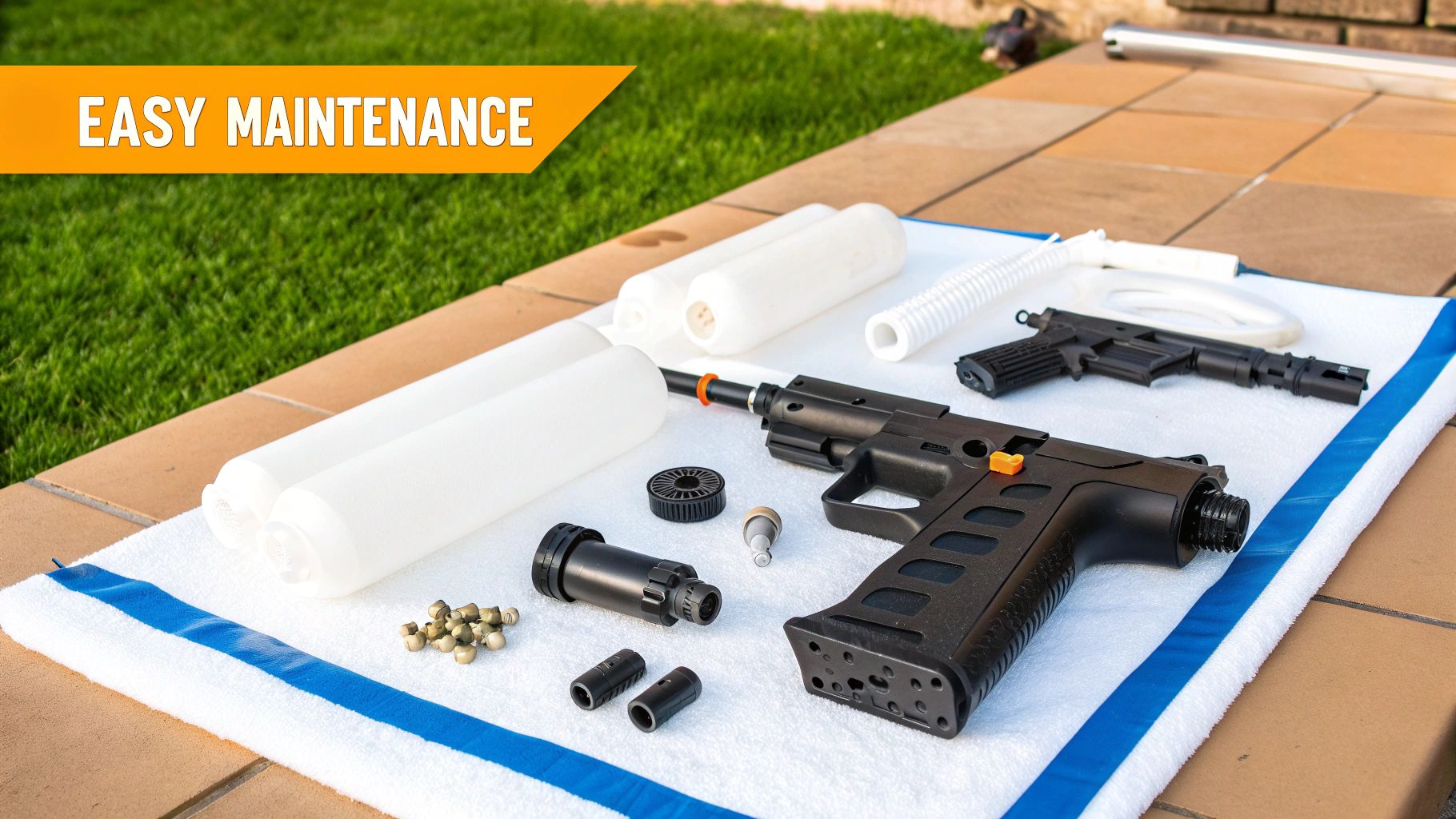If you’re hunting for the best car wash foam cannon, you've probably seen names like the Chemical Guys Big Mouth Max Release or Adam's Polishes Foam Cannon pop up. They’re both stellar options known for thick foam and solid build quality. But the right cannon for you really comes down to your pressure washer, your detailing ambitions, and what you’re willing to spend.
Why a Foam Cannon Is a Car Detailing Game Changer
For any serious DIYer or professional detailer, the foam cannon has become an indispensable part of the toolkit. It's a simple device that attaches to your pressure washer, blending soap, water, and air to shoot a thick blanket of suds all over your vehicle. This isn't just about making your car look like it's in a snowstorm—it’s a fundamental step for washing your car safely and effectively.

Safer and More Effective Cleaning
The real magic of a foam cannon is how it helps prevent scratches and swirl marks. That thick foam acts as a pre-wash, encapsulating and lifting dirt, dust, and road grime away from the paint's surface. By loosening all those abrasive particles before you ever touch the car with a wash mitt, you drastically lower the risk of grinding them into your clear coat.
This pre-soak does a lot of the heavy lifting. It makes the follow-up hand wash quicker, easier, and much safer for your paint. A good foam cannon will:
- Lubricate the Surface: The suds create a slippery layer for your wash mitt, letting it glide across the paint with far less friction.
- Improve Cleaning Power: Foam clings to vertical panels way longer than watery soap from a bucket. This extra "dwell time" gives the soap's cleaning agents more time to break down stubborn grime.
- Reach Tight Areas: It's great at getting into panel gaps, grilles, and other tricky spots that are a pain to clean by hand.
The core principle is simple: the less you have to scrub a dirty surface, the lower your risk of damage. A foam cannon lets the chemicals do the work, not your elbow, preserving your car’s delicate finish.
The explosion in popularity isn't just anecdotal. The global market for car wash foam cannons is on track to hit around $150 million in 2025 and is projected to grow by roughly 8% annually. This trend is fueled by more people taking up car detailing as a serious hobby and recognizing the superior, safer clean you get compared to a bucket and sponge. You can dig into the numbers yourself in this Data Insights Market research report.
Understanding What Makes a Great Foam Cannon
To pick the best car wash foam cannon, you first need to get what’s happening inside one. It’s actually a pretty clever, yet simple, device. A foam cannon uses your pressure washer's power to mix high-pressure water, car soap, and air into that thick, satisfying foam we’re all after.

Here's the quick version of the science. Water from your pressure washer is forced through a tiny hole inside the cannon, called an orifice. Squeezing the water through this small opening makes it speed up dramatically, creating a vacuum—this is known as the Venturi effect. That suction is what pulls soap up from the bottle and into the stream of fast-moving water.
At the same time, air gets sucked into the mix. This turbulent blend of water, soap, and air is then shot through a special mesh screen that acts like a whisk, whipping everything into the super-thick suds that make foam cannons so effective.
Key Components That Dictate Performance
Not all foam cannons are created equal. A few key parts are the real difference-makers between getting rich, clinging foam and a runny, soapy mess. The quality of these components is what separates the good stuff from the cheap knock-offs.
- Brass Body and Fittings: The main body, or manifold, is the heart of the cannon. You want to see solid brass here. It’s tough, resists rust, and won’t crack under the high pressure from your washer. Anything less just won't last.
- Stainless Steel Orifice: This tiny part plays a massive role. The size of the orifice needs to be properly matched to your pressure washer's GPM (gallons per minute) to get the best foam. It's a critical detail that many people overlook.
- Adjustment Knobs: A good foam cannon gives you control. There's typically a top knob to adjust the soap-to-water ratio (which tweaks foam thickness) and a nozzle at the front that lets you change the spray pattern from a pinpoint stream to a wide fan for covering big areas like a hood or door.
I see this all the time: people think dumping in more soap will create more foam. The real secret isn't the amount of soap, but the actual engineering of the cannon's body and having the right size orifice for your specific pressure washer. That's what truly creates that dense, stable foam.
Foam Cannon vs. Foam Gun: The Critical Difference
It's really important not to mix up a foam cannon with a foam gun. They sound similar, but their performance is night and day because they use completely different power sources.
A foam cannon must connect to a pressure washer. It needs that high PSI (pounds per square inch) to generate the thick, clingy foam that actually pulls dirt and grime off your paint.
A foam gun, however, just hooks up to a regular garden hose. Because your hose has much lower water pressure, a foam gun can only produce a thin, watery soap solution that slides right off the car. It's a step up from a bucket and sponge, for sure, but it can’t compete with the deep-cleaning power of a real foam cannon. If you want a proper pre-wash that safely lifts dirt away from the surface, you need a pressure washer and a quality foam cannon. It's that simple.
Comparing the Top Car Wash Foam Cannons
Picking the right foam cannon isn't just about grabbing the one with the best reviews. You really have to dig into how each model performs out in the real world—from the materials used to build it to the kind of foam it actually lays down on your paint. This side-by-side look focuses on those practical differences that separate a good tool from a great one.
We're going to break down the top contenders based on three things that truly matter: build quality, foam consistency, and everyday usability. These factors don't just tell you how the cannon will work today, but whether it'll still be your go-to tool a few years down the road. Let's see how they stack up.
Build Quality and Durability
The heart of any solid foam cannon is its construction. The best ones are built around a solid brass manifold with stainless steel fittings. This combo is key because it stands up to corrosion and handles the high pressures from your pressure washer without flinching. It’s honestly the biggest dividing line between premium and budget options.
For instance, a cannon like the Griot's Garage Brilliant Finish Foam Cannon gets a lot of praise for its beefy, heavy-duty brass components. You can just feel the quality. It’s not going to crack or spring a leak after a few dozen washes, making it a workhorse for detailers who use their gear constantly.
On the flip side, cheaper cannons often cut corners with plastic internals. While they might work fine out of the box, those parts are notorious for cracking and failing over time, especially when you factor in pressure spikes and harsh car wash soaps. Longevity is a real concern with those.
The infographic below gives you a great visual breakdown of the top models, comparing price, foam output, and how they’re rated for durability to make your choice a bit easier.

As the chart shows, there’s usually a trade-off. If you want top-tier durability and thick foam, you should expect a higher initial investment.
Foam Consistency and Adjustability
The real moment of truth for any foam cannon is the quality of suds it produces. What you’re looking for is that thick, shaving-cream-like foam that clings to the side of your car. That longer dwell time is what allows the soap to break down all the dirt and road grime. This is where good engineering and adjustability really shine.
The best models give you two main controls to dial things in perfectly:
- A top-mounted dial that lets you control the soap-to-water ratio. This is how you fine-tune the foam's thickness.
- An adjustable spray nozzle at the front. This lets you change the fan pattern from a focused stream to a wide spray, which is great for covering big panels like a roof or hood in one pass.
A common mistake is thinking that more soap automatically means thicker foam. The truth is, the cannon's internal mixing chamber and the size of its orifice have a much bigger impact. A well-designed cannon can whip up incredibly rich foam while using surprisingly little soap, which saves you a lot of money over time.
The Adam's Polishes Foam Cannon is a fan favorite for a reason—it just nails foam generation and is super easy to adjust. It consistently pumps out dense, clinging foam that provides tons of lubrication, which is exactly what you need for a safe, swirl-free wash. Its ability to throw a wide, even spray pattern makes foaming down an entire car quick and satisfying.
Usability and Ergonomics
Sometimes it's the little things that make the biggest difference. Practical features that improve the whole experience can easily set a great foam cannon apart from a merely good one. I'm talking about things like a wide-mouth bottle that you can fill without spilling soap everywhere, or a sturdy base that doesn't tip over the second you set it down.
This is an area where the Chemical Guys Big Mouth Max Release really shines. Among the foam cannons considered top contenders for 2025, it’s a standout for its fantastic foam and user-friendly design. It runs about $90 to $100 and has the largest adjustable nozzle of the bunch, giving you the widest spray pattern for laying down a thick, uniform blanket of suds. With a bottle capacity of 34 ounces, you can easily wash a big truck or SUV without stopping to refill. You can check out more details from these test findings from Car and Driver.
Foam Cannon Feature and Performance Showdown
This table provides a direct comparison of key specifications and performance metrics for the top-rated foam cannons, helping you quickly identify the best option for your setup.
| Model | Price Range | Bottle Capacity (oz) | Required PSI Range | Key Feature | Best For |
|---|---|---|---|---|---|
| Chemical Guys Big Mouth Max Release | $90–$100 | 34 oz | 800–3,500 | Wide-mouth bottle, extra-wide spray fan | Usability and large vehicles |
| Adam's Polishes Foam Cannon | $70–$90 | 32 oz | 800–3,500 | Exceptional foam consistency, easy adjustments | Achieving the thickest foam |
| Griot's Garage Brilliant Finish | $80–$100 | 35 oz | 1,100–5,000 | Heavy-duty brass and stainless construction | Long-term durability and frequent use |
In the end, choosing the best car wash foam cannon is about finding the right balance of durable construction, amazing foam production, and smart design. The Chemical Guys model is a winner for usability, Adam's Polishes is the king of foam consistency, and Griot's Garage brings that rock-solid durability. It all comes down to what you value most.
Getting Pro-Level Results With Your Foam Cannon
Just having a great foam cannon doesn't mean you'll instantly get that perfect, swirl-free shine. The real magic is in the technique, and it all begins with getting your setup dialed in. Nailing this part is what creates that thick, shaving-cream-like foam that does the heavy lifting for you.
First thing's first: you have to match your foam cannon's orifice size to your pressure washer's flow rate, which is measured in Gallons Per Minute (GPM). Most cannons ship with a standard 1.25mm orifice, and that's perfect if you're running a powerful gas pressure washer. But for those of us using a typical electric model (usually under 2.0 GPM), swapping to a smaller 1.1mm orifice is a game-changer. It creates more back pressure, which is the secret to producing much thicker foam.
Once your hardware is sorted, it's time to think about the soap-to-water ratio. A common mistake is thinking more soap equals more foam—it doesn't. In fact, you're usually just wasting product.
Dialing in That Perfect Foam
To get started, fill your cannon's bottle about three-quarters full with warm water. Using warm water really helps the soap dissolve and mix properly. Next, add 1-2 ounces of a quality, pH-balanced car wash soap designed for foaming. Give the bottle a gentle swirl to mix everything up, trying not to shake it so much that you create a foamy mess inside the reservoir.
You're looking for a consistency like shaving cream. It needs to be thick enough to cling to the side of your car for a few minutes but not so heavy that it just slides off in big globs. This "dwell time" is crucial because it gives the soap the time it needs to break down all that road grime.
After mixing, screw the cannon onto your pressure washer. You’ll use the top dial to control how much soap is mixed in and the front nozzle to adjust the spray pattern. I always recommend a wide fan pattern; it gives you the best, most even coverage for big panels like doors and hoods.
The Right Way to Apply Foam
With your cannon calibrated, the application itself is what makes the difference between a quick rinse and a true professional-level pre-wash.
Here's the process I stick to for a safe and effective wash:
- Always Pre-Rinse. Before you even think about foam, give the whole vehicle a good rinse with plain water. You want to knock off all the loose dirt and grit first, so you're not scrubbing it into the paint later.
- Foam from the Top Down. Start with the roof and let gravity do the work. The foam will run down the car, covering every inch and ensuring dirty runoff from the lower panels doesn't mess up the clean sections up top.
- Let It Dwell. This is where the patience comes in. Let the foam sit and work its magic for about 3-5 minutes. You'll actually see it encapsulating the dirt as it slowly slides down. The golden rule here is to never let the foam dry on the paint, especially if you're in the sun. Dried foam can leave nasty streaks and water spots that are a pain to remove.
- Rinse It Clean. Once the dwell time is up, rinse all the foam off, again working from the top down.
This whole process is designed to safely lift away the worst of the grime before your wash mitt ever touches the paint. If you want a deeper dive into how this fits into the entire wash process, this guide on using a foam cannon for a pressure washer is a great resource.
Choosing the Right Foam Cannon for Your Detailing Style

Let's be honest: there's no single “best car wash foam cannon” for everyone. Anyone who tells you otherwise is selling something. The right tool for you really comes down to your pressure washer, how often you’re washing your car, and what you’re trying to achieve with your detailing.
Instead of chasing a one-size-fits-all answer, it’s about matching the cannon to your specific setup and habits. Are you a weekend warrior who enjoys the ritual? A pro who needs a workhorse? Or someone just looking for a good, safe clean without breaking the bank? Each of those scenarios points to a different tool.
For the Weekend Enthusiast
If you're out in the driveway every couple of weeks with a standard electric pressure washer, you're looking for a sweet spot. You want that satisfyingly thick foam and dependable performance, but you don't need a cannon built to survive a war zone.
Focus on models with solid brass components, knobs you can actually turn with wet hands, and a wide-mouth bottle that doesn't make a mess every time you fill it. The real challenge here is finding a cannon that makes great foam with a lower-flow electric washer, which is often under 2.0 GPM. You want a fantastic pre-wash that protects your paint without paying a premium for commercial-grade durability you'll never use.
For the typical home user, the biggest game-changer is often a tiny, inexpensive part: the orifice. Swapping the stock 1.25mm orifice for a 1.1mm one can completely transform the foam from a standard electric pressure washer. It’s the secret to getting that thick, shaving-cream-like consistency without needing a powerful gas machine.
For the Professional Detailer
When you’re a pro, your foam cannon isn't a toy—it's a money-making tool that gets used and abused all day long. Durability is everything. You need a heavy-duty model with a beefy, all-brass manifold and stainless steel fittings that can handle high pressure, daily use, and a steady diet of different chemicals.
Look for cannons with larger bottles (32 oz or more) to avoid constant refills when you're tackling a big truck or lining up multiple cars. Features like smooth quick-connect fittings and precise, reliable adjustment dials aren’t just nice to have; they’re critical for maintaining an efficient workflow. For you, the best foam cannon is an investment that pays for itself in reliability and consistent, time-saving performance.
It’s also important to understand where these tools fit in your arsenal. We dive deeper into high-pressure versus low-pressure options in our guide covering the distinctions between a foam gun vs. a foam cannon.
For the Budget-Conscious User
Just getting into detailing or simply want a better wash without a big investment? You can still get fantastic results with a budget-friendly cannon. Yes, you'll likely see more plastic in this price range, but the trick is to find a model that still uses a brass core for the essential valve and nozzle components.
While it won't feel as solid as a premium model, a well-chosen entry-level cannon will blow any garden hose foamer out of the water. This corner of the market is huge for a reason—low-pressure foam guns are projected to be valued at around $500 million in 2025, largely because people want eco-friendly wash methods that save water. You can dig into the full market research report if you're curious about the data behind that trend.
Answering Your Top Foam Cannon Questions
Even with the best foam cannon in your hands, you're bound to have some questions. It's totally normal. Getting the small details right is what separates a decent wash from a truly safe, satisfying, and effective one. Let's dig into some of the most common things people ask so you can get professional results every time.
Mastering these fundamentals—from picking the right soap to fixing watery foam—will make a huge difference in your car care routine.
Can I Use Just Any Car Wash Soap in a Foam Cannon?
While you can pour any old car soap into your foam cannon, you really shouldn't if you want that thick, shaving-cream-like foam. You'll get much, much better results using a shampoo made specifically for foaming. These soaps are usually pH-balanced and packed with high-lubricity agents designed to explode into thick, stable suds under pressure.
Your standard bucket-wash soap just doesn't have the right stuff to create that dense foam. You'll likely end up with a watery mix that just slides right off the paint. And please, never use household cleaners like dish soap. They are way too harsh and will strip off any wax or sealant you have, leaving your paint totally exposed.
The secret to incredible foam isn’t just the cannon itself—it's the partnership between the cannon and the soap. A high-quality foaming shampoo is designed to create the clingy, dirt-lifting suds that are the entire point of a pre-wash.
Why Is My Foam Cannon Spraying Watery Foam?
This is easily the most common headache people run into, but don't worry, the fix is usually pretty simple. If you're getting runny, sad-looking foam instead of a rich blanket of suds, check these three things first.
- Your Dilution Ratio is Off: This is the number one culprit. Too much water and not enough soap (or even too much soap) can kill foam production. Most dedicated foaming soaps work best with about 1-2 ounces of soap for every 10 ounces of warm water. For a deep dive, check out our guide on finding the perfect foam cannon soap ratio for thick foam.
- Check Your Orifice Size: If you're using an electric pressure washer (usually anything under 2.0 GPM), the standard 1.25mm orifice that comes with most cannons might be too big. Swapping it out for a smaller 1.1mm orifice forces the water through a tighter space, which boosts pressure and can drastically improve your foam.
- Pressure Washer Output: Make sure your pressure washer is actually putting out enough power. A unit with low PSI or a weak GPM will always have a hard time producing thick, dense foam, no matter what soap or orifice you use.
How Do I Clean and Maintain My Foam Cannon?
Taking care of your foam cannon is incredibly easy, but it’s absolutely essential for keeping it working properly. After every wash, soap residue can dry up inside the mesh filter and brass parts, creating clogs that will completely ruin your foam quality.
The solution is simple: just run clean water through it when you're done. Fill the bottle with plain water, attach it to the cannon, and spray for about 30 seconds until the water runs clear. This quick flush cleans out any leftover soap, prevents blockages, and makes sure your foam cannon is ready to go for the next wash.
Ready to upgrade your detailing game with a tool that delivers professional results effortlessly? The SwiftJet Car Wash Foam Gun is engineered for maximum foam and convenience, turning any wash into a satisfying and effective experience. Shop now and get a free microfiber mitt with your order!
